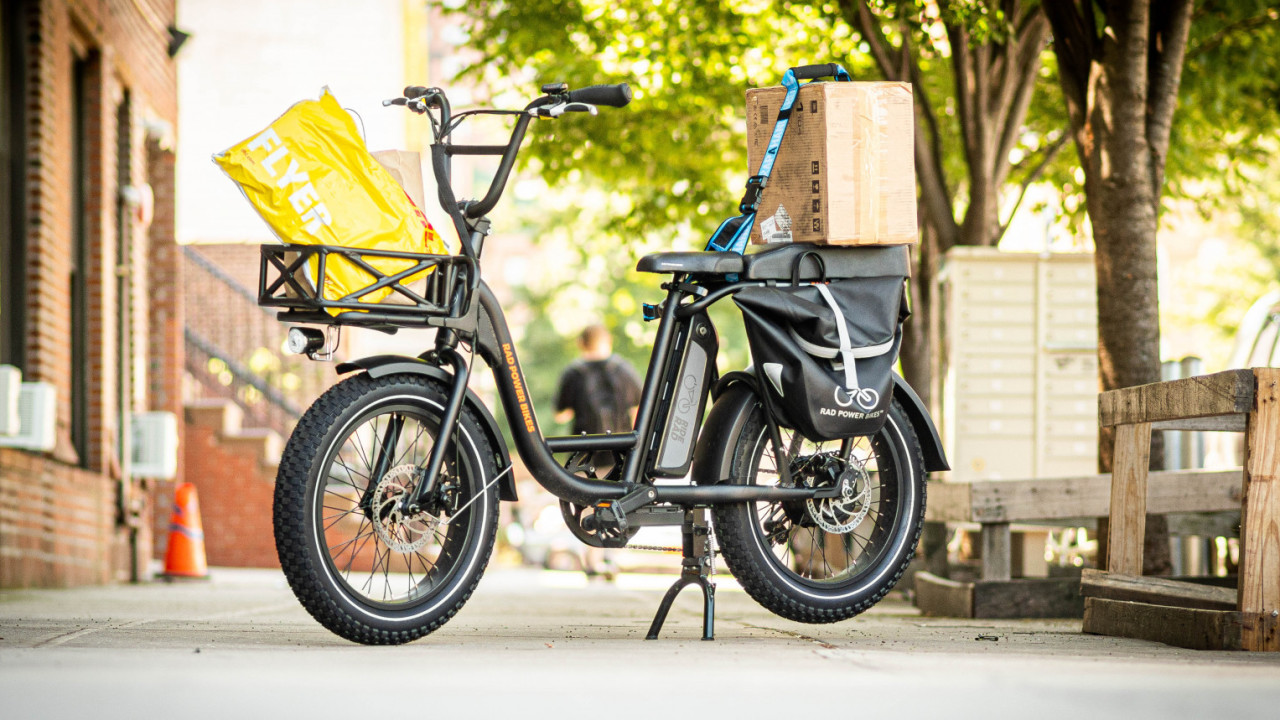
“Life is about the journey, not the destination.” So said someone who clearly never tried to get around Manhattan during rush hour.
There are myriad ways to navigate this city, but they’re rarely enjoyable. Like most New Yorkers, I don’t own a car. I’m lucky to work from home, but I go to meetings and run time-sensitive errands frequently. The subways are crowded and oft-delayed, walking will only get you so far, and cabs are expensive polluters. Carshare services like car2go aren’t much better.
The most consistent way of getting around the city quickly is almost certainly on two wheels. But though I’ve thought about braving the bike lane for years, bikes never seemed to have quite the utility I sought. I’d want to arrive at meetings across boroughs without being a sweaty mess, I’d need to carry heavy packages to couriers, and I might occasionally bring a passenger along for the ride.

So when Rad Power Bikes let me try its new RadRunner, a single-speed cargo e-bike that doubles as a moped, I thought I found the solution I was looking for. Now that I’ve spent several weeks and dozens of miles riding it, I think the RadRunner might be the solution a lot of city-dwellers are looking for. With an affordable (for an e-bike) starting price of $1,299, I wouldn’t be surprised if became one of Rad Power Bikes’ most popular models when it goes on sale September 10.
A quick disclaimer: I’ve been researching and considering e-bikes on-and-off for years, but I’m no bike expert. There are more technical breakdowns of this bike from more experienced cyclists elsewhere. Still, I hope these impressions are useful from the perspective of a relative newcomer.
If you’ve also been considering getting an e-bike, chances are you’ve come across Rad Power Bikes. It makes some of the most popular e-bikes around, and as an internet-direct company, it’s able to offer more bang for your buck than many brands that rely on dealers. The RadRunner pushes affordability further for the company, priced at $200 less than its siblings without skimping on performance. It does so while offering a unique blend of features. To summarize some of the key specs and goodies:
- 20mph top speed (pedal assist and throttle)
- Four levels of pedal assist via cadence sensor
- Twist-grip throttle
- Integrated bell
- 25-45+ miles of range
- 48V, 14Ah Samsung battery (672 wh)
- 65lb weight
- 300 lb rated payload capacity (120lbs on rear rack)
- 750W Geared Hub Motor rated for 80 Nm of torque
- Custom 20″ x 3.3″ puncture-resistant Kenda wheels
- Single-speed drivetrain with 52-16 gearing.
- Tektro 180mm mechanical disc brakes
- Included headlight and integrated brake light
- Optional ‘center console’ provides storage and can hold phone and cup
- Compatible with other brand accessories, including a front rack and cargo baskets on the front or rear
- Water-resistant design
- Dual-leg kickstand
- 44″ wheelbase, 67″ total length
- Recommended for heights from 4’11” to 6’2″
Many of these specs are similar to the company’s other bikes, but the RadRunner differentiates itself with a rare level of versatility. It’s one of few bikes designed to bring a passenger for the ride, it’s easy to use and low-maintenance, and it offers serious cargo capacity while being no longer than a typical bike.
The bike’s cleverest trick is its Passenger Package, which creates a hybrid bench extending from the driver position through the rear rack and adds footpegs for your co-rider. There are plenty of bikes with bench-style seats that can accommodate multiple passengers, but the RadRunner is the first I know that still lets you adjust the driver’s seat height. You can set it high up like a standard bike seat for full leg extension, or bring it down to fit flush with the passenger portion.

The latter makes the bike more like a moped and keeps you closer to the passenger, but I also just found it more comfortable for long, leisurely solo rides. It gives your butt a lot more padding and allows you to adjust your position mid-ride. There are some caveats though: the Passenger Package is an extra $99 and the driver’s seat isn’t particularly plush in a standard cycling position (though you can still use an aftermarket seat).

The bike oozes simplicity and practicality. The single-speed drivetrain may not be ideal for maximizing range or speed, but in practice, it makes a lot of sense for an e-bike. After all, gears are meant to help you climb hills, accelerate more quickly, and go faster. You know what else helps? A motor and throttle.
If I’m climbing a steep hill, a twist of the throttle gives my legs immediate power, and the bike’s pedal-assist kicks in after a heartbeat or two. On other e-bikes, like the Juiced CrossCurrent X I’m also testing, I find I tend to stick in one pedal assist level and use the throttle sparingly, using gears to do most of the work. On the RadRunner, the pedal-assist levels basically act as pseudo-gears, still allowing me to go faster or slower for a given amount of effort, and the sensitive throttle allows further nuance.

Most of the time, I don’t really miss the gears, especially given the added peace of mind and durability of a single-speed. I expect many other newbie cyclists would feel similarly.
With the 750W geared hub motor, cruising around 100 pounds of cargo was a cinch. Rad Power Bikes sells a wide range of accessories, including pannier bags and front and rear baskets. I installed a basket on the front also tried a large basket for on the rear, but ultimately found myself sticking with just the passenger seat. Using some carrying straps to secure my cargo, the long and mostly-flat passenger seat actually worked great as a platform for stacking boxes.

Unfortunately, I wasn’t able to try out the RadRunner’s unique center console at the time of writing, which fills the step-through frame with a cup holder, phone slot, and extra storage space. I’ll update this review once I receive one in September.
My one big caveat about the cargo design is that the RadRunner isn’t technically designed to handle the passenger seat and pannier bags at once. Either you use it as a rack, or you use it as a seat. That’s a pain, as even with no passengers, you’d have to remove the seat every time you wanted to carry a bunch of groceries.
But I say “technically” because I found I could just barely squeeze the pannier’s hooks onto the frame under the passenger seat. For future versions, a few extra millimeters of clearance between the seat and the frame would solve the problem. In the meantime, you can just add a couple of washers when installing the seat.
The RadRunner is rated for a 300lb payload (rider+cargo) but I suspect that figure is quite conservative (perhaps for warranty reasons or to protect the motor). I push that limit every time I ride it, weighing in at around 270lb on my own and generally carrying a messenger bag and three heavy-duty locks (hey, it’s an expensive bike in theft-prone NYC). The frame feels super sturdy, and the wheels have thick spokes.
Add some actual cargo, and I’ve ridden the RadRunner with payloads of over 350lb on several occasions, and once pushed it to about 420 lb. Of course, I don’t recommend you go over the bike’s specification, but I never felt like the frame, wheels, or brakes would fail on me. As a bonus, the stable dual-leg kickstand makes loading cargo easy.
Actually riding the RadRunner is a blast. I appreciated not having to worry about gears and the constant clanking of shifting. Set an assist level, then simply pedal faster to go faster, or use the throttle when you need a boost. I found the gear ratio comfortable for cruising along around 15-17 mph or so in pedal assist level 2 without getting sweaty. And though the cadence sensor isn’t as immediate or precisely responsive as the torque sensors on more expensive bikes, it’s not something I expect will bother most people.

Mind you, with a 20mph assist limit, you won’t be breaking any speed records. I wish it went a little faster with pedal-assist – e-bikes will soon be legal up to 25mph in NYC – but you’ll still be zipping by the average cyclist and riding comfortably alongside crowded city traffic. To be clear, you can go faster, especially on any sort of decline, but the motor won’t help you beyond 20mph.
Despite the RadRunner’s cargo chops and massive rear rack, the smallish wheels help the RadRunner feel nimble. At 67 inches long, the bike is a normal length, and the semi-fat 3.3-inch tires strike a pleasant balance between agility and comfort. The bike handled a few rides in the rain with aplomb, and I found myself not missing suspension even in rough NYC pavement. In fact, with the tires at their recommended pressure, I actually found the ride generally slightly more comfortable than the CCX – which has front suspension – when riding over deformities. This isn’t to say the CCX is uncomfortable, it’s just a reminder that tire pressure is part of your suspension too. If you’re a lighter rider, you could probably bring down the RadRunners tire pressure a bit and get similar results.
At night, I found the headlight bright enough to both see and be seen, and I appreciate that the integrated tail-light reacts to your braking and can be set to flash for added visibility.
Given I’m a heavy rider, I was concerned about range, but was pleasantly surprised to find myself within Rad Power Bikes’ estimates. Using pedal-assist levels 2 and 3 with the occasional throttle, and riding on mostly-flat NYC terrain, I was able to achieve 27 miles on the one occasion I drained the battery entirely. Lighter riders should be able to get a fair bit more range.
Just don’t forget to charge. It stills works fine as a bike with a dead battery, but you’ll feel the bike’s 65-pound weight moving from a dead stop with no gears to help you.
I do have a few complaints. I wish the bike came in more than just black and dark green, partly for aesthetics, and partly to aid visibility at night. The simple LED display helps cut down on costs, but I consider having a speedometer a safety feature. I wish I could mount a second battery, perhaps under the rear rack, or buy a bigger one. Fenders should be included by default. And after trying some faster e-bikes, I think a top speed closer to 25mph is more suitable when the bike lanes run out.

But those caveats aside, the RadRunner seems to offer something for almost anyone who cares about utility more than sheer speed.
It’s affordable (for an e-bike), easy to use, simple to maintain, comfortable to ride, and one of the most versatile designs I’ve seen. There is no shortage of cargo e-bikes, but few offer quite as much for so cheap. If you’ve been looking for an e-bike to help you get stuff done without a car – especially if you want to bring someone along for the ride – you’d be hard-pressed to match the RadRunner’s value and performance. It’s nice to actually enjoy the journey, for a change.
The RadRunner will be available from Rad Power Bikes on September 10.
Get the TNW newsletter
Get the most important tech news in your inbox each week.



